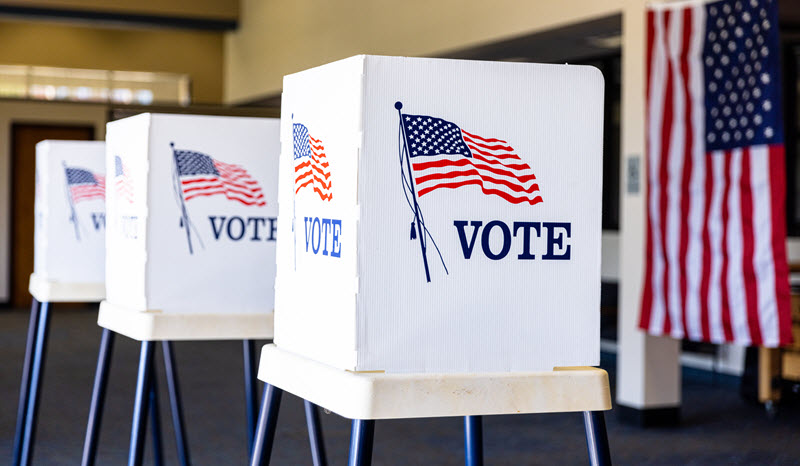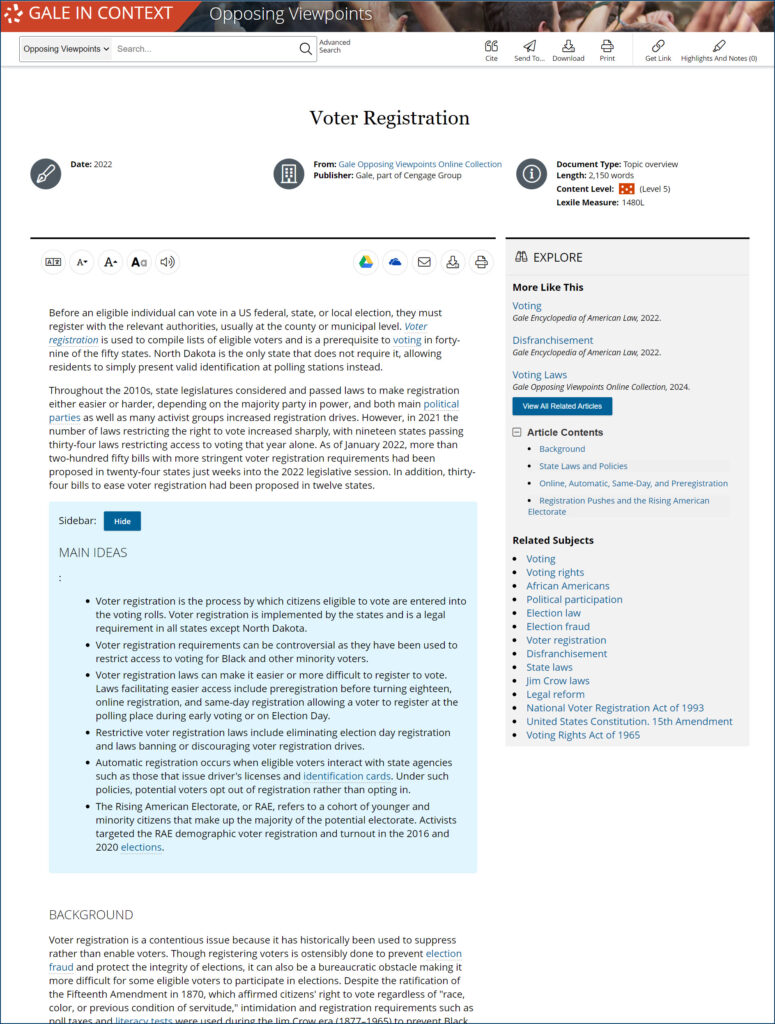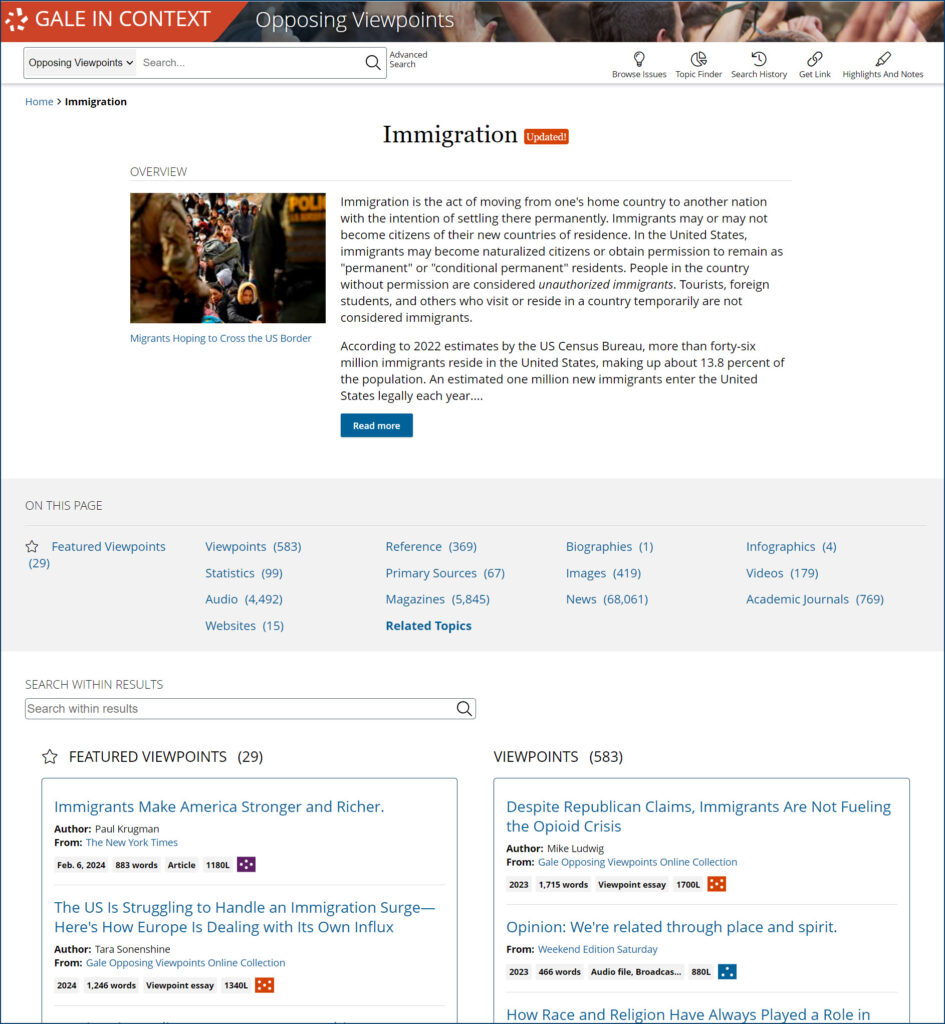| By Gale Staff |
In many states, teenagers can register to vote before they turn 18—but there is no age limit for learning about the democratic process. Experts encourage early voter education. A 2020 study found that students who learned about the voting process in high school were “more likely to vote and participate in other civic activities” and “more knowledgeable about voting processes.”
Young voices could significantly impact the 2024 election, as 16 million Americans have turned 18 since the last presidential race. As a country, however, we have room to grow voter engagement. The Pew Research Center ranks the United States 31st in voter turnout among democratic nations. Targeted voter registration efforts in high schools could inspire better engagement.
Ready to get your students fired up to vote once they turn 18? Here are ideas to get you started—including how Gale resources can help.
Register to Vote
Registering to vote is the crucial first step. Introduce your classroom to the voter registration process with the comprehensive summary page in Gale In Context: Opposing Viewpoints. According to the National Conference of State Legislatures, just over half of U.S. states allow individuals to register to vote before they turn 18, with many allowing registrants as young as 16. The process is easy, but it can seem confusing if an individual moves or has unique circumstances.
Most states allow people to register online, so you can have students start the process in class. Once students sign up, most states issue a voter card or confirmation outlining where to vote on Election Day. Some states ask that registrants declare their political party as well. Have students look up their state’s election center to learn about specific requirements for Election Day (most states just require a valid photo ID). Rock the Vote has helpful FAQs for students with questions about citizenship or absentee ballots.
Demystify the Electoral College
The American presidential election system is complex, and a large part of that complexity comes from the Electoral College. As a class, take time to understand these complicated topics and outline the electoral process.
Election Day is always the first Tuesday in November—unless the first Tuesday coincides with the first of the month, in which case it moves to November 8. However, there’s another vote that occurs in mid-December, when each state’s electors vote on behalf of their constituents. The number of electors corresponds to each state’s Electoral College votes—totaling just three for the nation’s least populous states (Alaska, the Dakotas, Delaware, Vermont, and Wyoming), all the way up to 54 for California with its nearly 40 million residents.
The logic behind the Electoral College system traces back to the Founding Fathers; they believed the process granted more autonomy to states during federal elections. It captured the votes of individual citizens, while elevating the voices of less-populated states, seeking proportional representation across the country.
In recent years, there has been increased conversation around eliminating the Electoral College, with some believing it’s no longer constructive to our modern democracy. Ask students to read multiple points of view from varied sources in Gale In Context resources to weigh the pros and cons of the system. This is an opportunity not only to educate students on the history of the Electoral College but also to practice essential skills like critical thinking, media literacy, and more.
Understand Political Parties
Many Americans classify themselves as either a Democrat or a Republican, but what do those parties actually stand for? Despite the pervasiveness of the country’s two-party system, other political camps do exist. A significant number of Americans identify as independent and don’t strictly subscribe to either of the leading parties’ platforms.
Have students take a quiz to identify what causes interest them and which current presidential candidate best matches their opinions. Emphasize the importance of respecting different political beliefs as a cornerstone of democracy. Students don’t necessarily have to share their results—it may be interesting to conduct an anonymous poll to help celebrate your classroom’s political diversity.
Research a Major Issue
Informed citizens not only learn about major political issues, but they also aspire to understand both sides. Show your high schoolers how to approach complex debate topics with an open mind and willingness to hear multiple perspectives with Gale In Context: Opposing Viewpoints.
Using Gale In Context: Opposing Viewpoints, ask students to conduct in-depth research on an issue that’s important to them. They might wish to peruse the extensive topic pages about today’s top issues. Ideas may include drug legalization, capital punishment, immigration, the Israeli-Palestinian conflict, or LGBTQ+ marriage equality. Vetted by subject matter experts, the content offers viewpoints from different perspectives around the United States and the world, while still giving students a safe, age-appropriate space to explore complicated issues.
Encourage students to consider their stance on their chosen issue and mindfully commit to studying the opposing side. You could even host a mock debate. To kick things off, take advantage of Gale’s critical-thinking questions embedded in each topic’s summary page. Plus, students can easily cite their arguments with each article’s built-in citations.
Attend a District Meeting
Local elections don’t get the same attention as federal contests, but they greatly impact your community. Down-ballot topics may include library funding, property taxes, and local political offices. Without major lobbying and with fewer participants, down-ballot voting gives the community more of a voice. Local elections are the foundation of democracy.
In some districts, there is a new push for high schoolers to vote in local elections—specifically for school board positions. Whether or not your students can legally vote, there is value in attending local school board meetings. Encourage participants to share what they learned; your students may find a surprising interest in the issues affecting their district. You could even offer extra credit to students who attend a meeting.
Emphasize Digital Media Literacy Skills
Introduce the Disinformation and Misinformation topic page in Gale In Context: Opposing Viewpoints, and discuss strategies for identifying accurate, unbiased information online. Digital media is an essential way for politicians to inform the public about their agendas, but it also creates opportunities for misinformation. Ensure students understand how to vet sources, dodge clickbait, and avoid confirmation bias.
This is especially critical following recent elections. During the 2016 election, 44.3 percent of Americans accessed websites housing “false or misleading information.” Misinformation threatens accurate research, and students must carefully approach the content they consume—especially on social media.
High school teachers are vital to successfully engaging the next generation in the democratic process. The classroom is a safe space for high school students to be curious about the upcoming election and what fuels political issues. Regardless of their stance, high school graduates must know how to stay accurately informed and open-minded about political perspectives.
If your school doesn’t currently have access, learn more about Gale In Context: Opposing Viewpoints.



